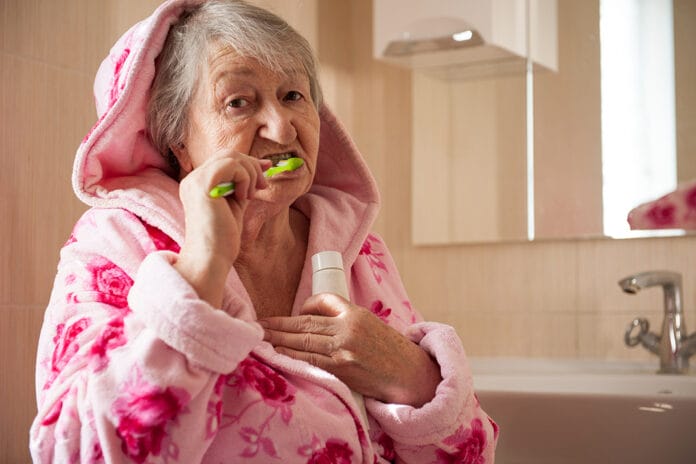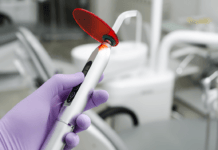As human beings age, disease progression occurs more frequently and rapidly. Oral health providers understand the systemic connection between the mouth and the rest of the body. However, this concept can remain foreign to a large percentage of the general population and is sometimes even disregarded by other trained medical professionals.
For dental professionals, adequate plaque biofilm removal from the oral tissues is a primary goal in promoting oral health. Bacteria housed in the biofilm can cause dental caries and all extents of periodontal disease, including gingival inflammation, bone loss, connective tissue loss, and ultimately tooth loss.
Oral health providers also understand that the oral-systemic link results from the risk of bacterial pathogens in the mouth traveling through the bloodstream, which can create the development of disease as a result of disease in the oral cavity. One well-known example is diabetes. Extensive research relates the connection of diabetes to a higher risk of periodontal disease and vice-versa.
Systemically, bacteria from the oral cavity can also travel through inhalation into the lungs, also called aspiration. One disease resulting from aspiration that can be linked to periodontal pathogens, especially in elderly patients, is aspiration pneumonia.
Effects of Aspiration Pneumonia on Elderly
Aspiration pneumonia can occur when contents of the oral cavity (such as foods or beverages, saliva, or vomit) enter the lungs, causing an infection. Slight aspiration is common and generally causes no problems. Excessive aspiration can occur and results when the gag reflex is reduced, often caused by brain injury or decreased cognitive function, decreased swallowing ability, or during impairment such as when using alcohol or drugs. Older individuals have a high prevalence of reduced brain function due to Alzheimer’s disease or dementia and decreased swallowing ability due to xerostomia, medications, or other medical conditions or complications.
Symptoms of aspiration pneumonia include chest pain, cough that is often productive, fatigue, fever, decreased body temperature, nausea, vomiting, diarrhea, shortness of breath, and confusion or cognitive changes.1
Aspiration pneumonia can be deadly; thus, reducing the risk of contraction is vital, which can be potentially achieved with proper oral health care on a regular basis. Elderly patients living in long-term care facilities or those who are patients in hospitals are at an increased risk of developing this condition. Though these individuals can often have multiple conditions and predispositions to pneumonia, oral health and prevention of disease should remain a priority for these individuals.
Strategic Oral Care
Older individuals can also face an endless list of barriers to care, especially those dependent on another person for their activities of daily living. These obstacles can include lack of education or training for the person providing care, lack of confidence to complete the desired task, neglectful personal dental care for the individual providing care (resulting in less priority to the care of the mouth), and also the refusal of the dependent person from accepting oral care. Although these obstacles are valid, they should be properly addressed to promote oral health and systemic health for the elderly patient.
When discussing oral health in the reduction of aspiration pneumonia, research has begun to answer whether increased and strategic oral care can be more effective in reducing aspiration pneumonia.
Additionally, due to an increase in knowledge and interprofessional collaboration, research in this area will help bridge the gap between medical and dental providers. In evaluating these studies, connections between aspiration pneumonia and risk factors have been identified. Some of the results even link aspiration pneumonia directly to proper oral care. This specific topic has also identified a need for collaboration between nursing home or hospital staff and dental providers.
Studies Regarding Oral Health Care Intervention
One systematic review (van der Maarel-Wierink et al.) utilized five published works in this category to answer the question of whether providing adequate oral health in older people influenced the risk of developing aspiration pneumonia. The authors determined that regular, specific oral care was the primary intervention to reduce the development of aspiration pneumonia. Of the five included works, two concluded that increasing the individual’s oral health reduced the risk of contracting and dying from aspiration pneumonia. The other three studies determined that providing adequate oral care can decrease the potentially harmful bacteria in the oral cavity but recommended improving the swallowing and cough reflexes of the individuals to reduce aspiration pneumonia.3
Some of the most specific and profound results included in this study by van der Maarel-Wierink et al. were listed from the study of Yoneyama et al. The results determined that the control group, which were providing basic oral care for themselves, had a statistically significant increased incidence of “febrile days, pneumonia, and dying from pneumonia.” The experimental group from this study was receiving oral cleansing after meals from a care provider that included tooth brushing without paste within five minutes of eating, 1% povidone-iodine when tooth brushing was not sufficient, and professional dental care once per week.3
From these results, one can see that oral health aids in the reduction of aspiration pneumonia, but it is often a two- or three-fold conclusion. One example of this is seen in the study from Watando et al. assessed in this systematic review. Authors van der Maarel-Wierink et al. gave the conclusion of the study by stating, “Cleaning the mouth by care providers during five minutes after each meal resulted in significant improvement of cough reflex sensitivity, suggesting a reduction in aspiration pneumonia.”3
Though many significant contributions to this problem resulted from this review, final conclusions by van der Maarel-Wierink et al. determined that there were not enough consistent studies due to the variation of outcome variables to determine the true desired oral care intervention to decrease or prevent the incidence of aspiration pneumonia. The authors closed their report by stating that, according to their results, strategic oral care, including cleaning the mouth after meals, cleaning dentures or other dental prosthetics once per day, and providing professional oral care once per week, appears as the best intervention to reduce the development of aspiration pneumonia in the dependent elderly.3
In a separate systematic review written by Pace and McCullough, the authors provide a review of oral flora and the etiology and biology of bacteria during disease progression. They then explain that bacterial presence is not the only factor that leads to periodontal disease. They list seven criteria for disease development, including, but not limited to, susceptibility, the number of pathogens and if the count exceeds a specific threshold, and location of pathogens. The authors also explain risk factors of both local and systemic links to periodontal disease such as dietary influences, especially high sucrose and carbohydrate diets, functional problems such as occlusal trauma, and deficient restorations.2
Pace and McCullough then relate periodontal disease to aspiration pneumonia by first outlining the risk factors of the latter. They listed risk factors from a study by Langmore et al. that include “dysphagia, feeding status, functional status, medical status, and oral/dental status.” The authors then discussed their concluded findings of the connection between decayed teeth, lack of or decreased brushing tendency, dependence on assistance for oral care, and tube feeding to aspiration pneumonia as statistically significant findings (p=0.01).2
Pace and McCullough continue by attempting to answer the question of what oral care interventions are necessary to decrease the incidence of aspiration pneumonia. They evaluated both chemical and mechanical methods of oral care, addressing the use of chlorhexidine gluconate ─ either rinsed (if able) or applied, tooth brushing ─ completed after eating by a care provider, professional oral care, oral sponge use, and electric toothbrush use.
Of the chemical studies, it was determined that an antimicrobial agent is effective in the reduction of bacteria, but the authors close this section by explaining that questions of proper usage for ideal effectiveness remain. In the mechanical studies, it can be concluded that oral care provided strategically for each patient is ideal, but more training and specification on how to complete oral care is necessary. The authors close their review by explaining what training is essential and how to sustain oral care as a prevention method into the future.2
From this included research, oral health professionals should focus significantly on their home care education for elderly patients providing their own personal care, and work with personal caregivers to improve these individuals’ daily oral cleaning habits. Though it is not currently known what methods of home care are the most effective in the prevention of aspiration pneumonia, training programs for those providing care in facilities should be prioritized and may be something that oral health providers should advocate for moving forward.
Before you leave, check out the Today’s RDH self-study CE courses. All courses are peer-reviewed and non-sponsored to focus solely on high-quality education. Click here now.
Listen to the Today’s RDH Dental Hygiene Podcast Below:
References
- (2020, June 13). Mayo Clinic. Retrieved from https://www.mayoclinic.org/diseases-conditions/pneumonia/symptoms-causes/syc-20354204
- Pace, C.C., McCullough, G.H. The Association between Oral Microorganisms and Aspiration Pneumonia in the Institutionalized Elderly: Review and Recommendations. Dysphagia. 2010; 25: 307-322. Retrieved from https://pubmed.ncbi.nlm.nih.gov/20824288/
- Van der Maarel-Wierink, C.C., Vanobbergen, J.N.O., Bronkhorst, E.M., Schols, J.M.G.A., de Baat, C. Oral Health Care and Aspiration Pneumonia in Frail Older People: A Systematic Literature Review. Gerodontology. 2012; 30(1). Retrieved from https://pubmed.ncbi.nlm.nih.gov/22390255/











